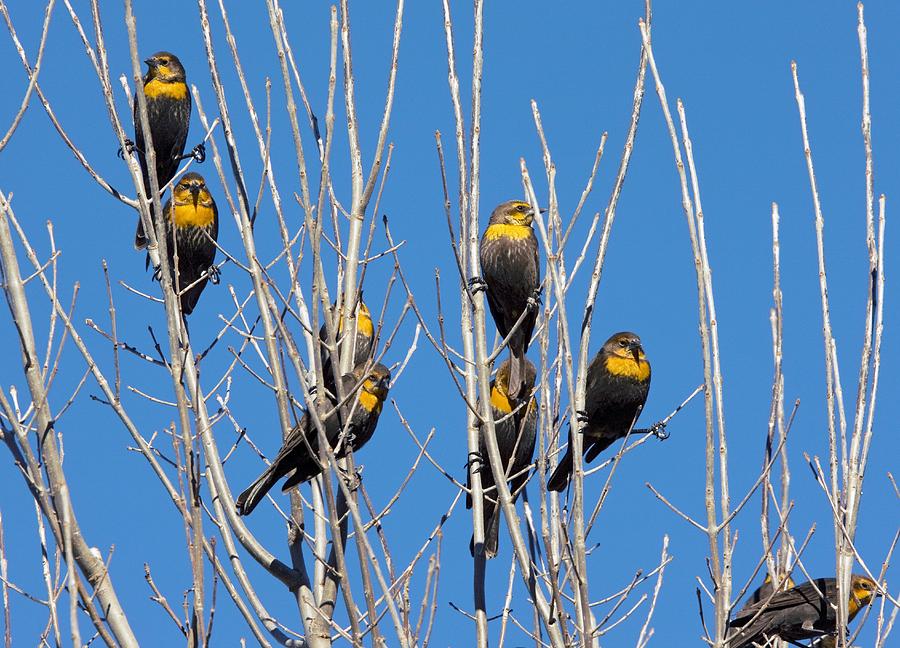


Striped sunflower seeds are especially difficult for starlings to open. But their bills are rather weak for cracking them open. Like most seed eating birds, starlings like sunflower seeds. And birds that don't like that single seed will stay away from that feeder. That way birds won't kick out seeds they don't like. Place one kind of bird seed in each feeder. The stuff they don't want to eat? They kick it out on the ground under the feeder, attracting grackles, blackbirds, and starlings. If milo is listed first in bird seed ingredients, don't buy it!īirds pick through mixed seeds looking for their favorites. Quail, doves, house sparrows, cowbirds, and blackbirds like these ingredients.
FLOCKS OF BLACKBIRDS CRACKED
Stay away from foods with milo, oats, wheat, and cracked corn. Related: 7 Kinds of bird feeders and the birds that like themĭon't feed birds cheap mixed seeds! These mixed seeds are derived from the poultry industry where "chicken scratch" is cheap and sold as bird food. Here are some upside-down suet feeders from Amazon. But grackles and starlings have a very difficult time eating from these types of suet feeders. Even the largest of the woodpeckers can get to the suet with ease. This is no problem for wrens and titmouses and nuthatches. Birds must fly up under the feeder and hang on to eat. This will allow only a limited number of birds to eat at a time-perhaps saving you bird food costs! Check out "squirrel resistant" bird feeders on Amazon. Perhaps an added benefit is that the feeder ports will close if a whole flock of small birds get on the feeder at once. Such adjustments will, however, also keep out jays and cardinals, too. Find such feeders that allow you to adjust the weight sensitivity.īlackbirds may weigh 3 to 4 times as much as a finch or chickadee. These feeders have weight-activated perches that close when a heavy squirrel gets on them. Check out different kinds of caged tube feeders at Amazon. Some birds such as cardinals and grosbeaks may also have a difficult time getting in, though. This is very effective in keeping bigger grackles and blackbirds and most starlings out of the feeder. Smaller birds like chickadees and finches go right through the bars. Check out a wide variety of tube feeders from Amazon.Īnother type of tube feeder is enclosed in a metal cage. Starlings will fall off these types of feeders, or at least have a very difficult time hanging on to get to the food. There are some tube feeders with feeding ports under the perches! Finches and nuthatches and chickadees have no trouble hanging upside down to feed from these. Others have removable perches just to solve this blackbird problem. Some of these tube feeders don't even have perches. Find tube feeders without trays at the bottom so that these larger grackles have no place to stand. This makes it easy for flocks of starlings or grackles or blackbirds to consume all your food in short order. Numbers of birds can share the platform at the same time. These are open to all birds with a wide shelf for them to stand on and eat. There are several changes you can make to your bird feeders to help get rid of unwanted blackbirds, starlings, and grackles.įirst of all stop using platform feeders. Image by PublicDomainPictures from Pixaby There may be some times of the year you don't have to be so aggressive in getting rid of these birds and keeping grackles, blackbirds, and starlings away from your bird feeders. But you may not have to apply these remedies all year. If your problem is a seasonal issue the solution is still the same. If anyone has trouble with Yellow-headed Blackbirds, well, I'm jealous! They are migratory, too. They also migrate northward in the summer.Įuropean Starlings, Boat-tailed Grackles in the East and Great-tailed Grackles in the West are non-migratory. Brewer's Blackbirds in the West and Rusty Blackbirds in the East only form large flocks in the fall and winter. They move to the marshes to breed in the summer. Red-winged Blackbirds generally only visit feeders in the winter. Grackles in these latter locations might only be a problem in spring or fall migration. Elsewhere Common Grackles are migratory in the Northeast, Midwest, eastern and central Canada, and the Great Plains. They are resident in the Southeast and can be a problem all year. Is this a seasonal issue or do you have blackbirds all year?Ĭommon Grackles can be a problem in the East.


 0 kommentar(er)
0 kommentar(er)
